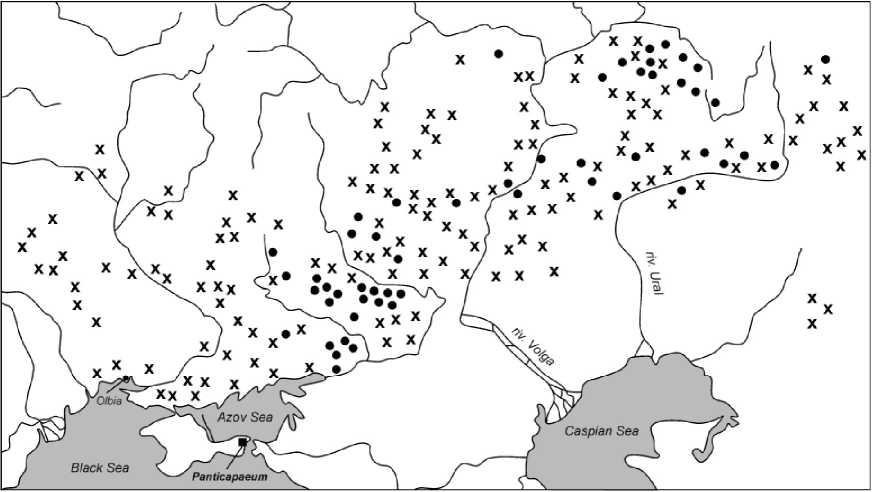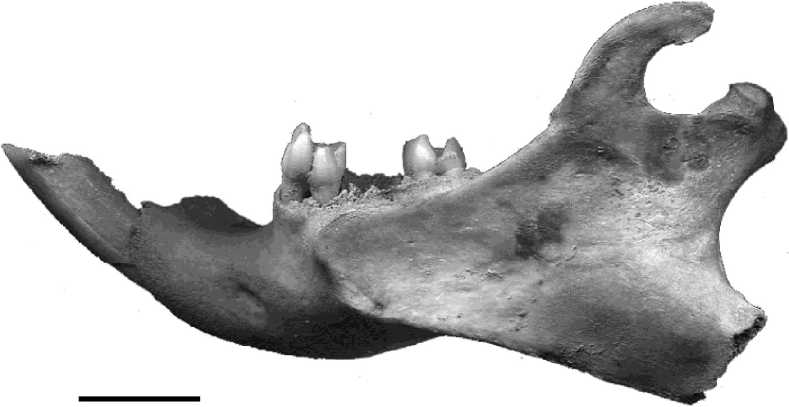О находке костей байбака ( Marmota bobak Muller, Rodentia) в древнем Пантикапее (Керченский полуостров, Крымский полуостров, Россия)
Автор: Зиновьев Андрей Валерьевич
Журнал: Вестник Тверского государственного университета. Серия: Биология и экология @bio-tversu
Рубрика: Зоология
Статья в выпуске: 3, 2015 года.
Бесплатный доступ
Настоящее сообщение посвящено описанию и первичному анализу находки костей байбака в слоях первых веков нашей эры в греческом городе Пантикапей. Это первое сообщение о находке костей в самой восточной части Крымского полуострова (Керченский полуостров). Хотя животное могло быть привезено с северных берегов Аральского и Черного морей из-за ценного мяса и жира, сохраняется большая вероятность его обитания в этой области полуострова в начале нашей эры.
Короткий адрес: https://sciup.org/146116599
IDR: 146116599 | УДК: 599.32
Текст научной статьи О находке костей байбака ( Marmota bobak Muller, Rodentia) в древнем Пантикапее (Керченский полуостров, Крымский полуостров, Россия)
Introduction. Scattered bones of the representatives of the genus Marmota are known in Eurasia from the end Pliocene. However, they become numerous only by the Late Pleistocene (Zimina, Gerasimov, 1973). Morphological similarity of the thirteen species, belonging to this genus, supports their recent diversification, proved by molecular and genetic analyses (Vorontsov et al., 1969; Brandler, 2003). Adapted to the cold steppes of the periglacial zone, marmots have widely spread over Eurasia during the Valdai (Wiirm) glaciation. One of the species, the Steppe, or Bobak Marmot, has its modern distribution in Ukraine, western part of the European Russia, on the Middle Volga and Middle Ural, in the southern Urals, as well as in the steppes of the Northern Kazakhstan (Ognev, 1947). Modern disrupted areal of the Steppe marmot is evidently the remnant of the once more continuous distribution (Zimina, Gerasimov, 1973; Kirikov, 1980). The western border of the past distribution of the marmot has reached the western Germany (Brand, Woldrich, 1887), while the southern border has enclosed the northern shore of the Black Sea (see Figure 1). Bones of the Steppe marmot have been discovered by LG. Pidoplichko (1938) on the course of excavation of the ancient Greek city Olbia; A.A. Brauner (1913) recorded the lost burrows of the Steppe marmot in the former Taurian Province of the Russian Empire (fig. 1). Bones of the marmot are known from the foothills of the Crimea (Gromov et ah, 1965; Markova, 2011), although the question on the time of its disappearance from the Crimean peninsula remains open. Marmot bones have never been reported from the Kerch Peninsula.
Historical background of the site. The ancient Greek city Panticapaeum was founded by Milesians and build between 7th and 6th cent. BC on the Mount Mithridat. The city became the residence of the Thracian kings of the Bosporus in 5th - 4th cent. BC. Then it was left to the famous Mithridates VI Eupator, king of Pontus. Panticapaeum gradually became the colony of the Roman Empire after the suicide of Mithridates in 63 BC. The city was destroyed by the Huns around 370 AD. Coming under the control of the Byzantine Empire, the city was rebuilt and developed later into the modern city of Kerch.

Fig. 1 . Map showing past (x) and present (•) distribution of the Steppe Marmot and the location of ancient Greek cities Panticapaeum and Olbia (after Ognev, 1947 with changes)
Рис. 1 . Карта прошлого (x) и нынешнего (•) распространения байбака с указание древнегреческих городов Пантикапей и Ольвия (по Огневу, 1947 с изменениями)
Material and methods. The material for this study is a left mandible of the Steppe Marmot, excavated on the Upper Mithridat excavation site by the Bosporus Expedition of the Pushkin State Museum. The mandible was found the cistern (fig. 2), carved in the rock and filled with household refuse by the 4th cent. AD (V.P. Tolstikov, pers. comm.). The tip of the angular process, as well as the first and third molars of the mandible have been lost during the excavations (fig. 3). The age of the animal was subsequently determined according to the specifications by Yang, Zhang (1986).
Results and discussion. The mandible belongs to the adult marmot of 8-9 age stages (Yang, Zhang, 1986). This means, that the marmot has lived already more than a half of its average lifespan, estimated in 7 - 10 years (de Magalhaes, Costa, 2009). The bone lacks any traces of butchery and gnawing.

Fig. 2 . The entrance to the cistern, carved in the rock, where the mandible of the Steppe Marmot was discovered (photo by the author) Рис. 2 . Вход в цистерну, выдолбленную в скале, в которой была найдена челюсть байбака (фото автора)
The discovery of the marmot lower jaw in the ancient Panticapaeum cannot directly prove the Steppe Marmot distribution in the Kerch Peninsula during the first centuries AD. The discovery of the mandible in the cistern, filled with household refuse could point onto the practical use of the marmot; its meat is tender and fat, close to the meat of the lamb. In this case the animal can be shipped from the northern shores of Azov and Black Seas, where it has lived in the historical time (Pidoplichko, 1938; Ognev, 1947; Abelentsev, 1971). However, the lack of the processing makes this hypothesis less viable. In case of the export of the Marmot for the meat’s or fat’s sake the head and the skin should have been left in the area, where the animal has been hunted. We also do not know any historical and archaeological records of the use of the marmot meat and fat in the region. Further discoveries of the marmot bones across the Crimean peninsula are necessary to reconstruct the picture of the animal distribution throughout the region.
Conclusions. The mandible of the Steppe Marmot, found in the ancient city of Panticapaeum, shows its presence on the Kerch Peninsula (easternmost part of the Crimean Peninsula) in the first centuries AD. Although the transportation of the animal from more northern areas was possible, the probability, that the marmot has once inhabited this region, is relatively high.

Fig. 3 . Left branch of the Steppe Marmot’s mandible, found in Panticapaeum (photo by the author).
Рис. 3 . Левая ветвь нижне челюсти байбака, найденная в Пантикапее (фото автора).
Acknowledgements. I would like to thank Vladimir Tolstikov of the Pushkin State Museum (Moscow, Russia) for providing a material and dating. I am also grateful to Dmitry Kalinichev from the same Museum for assisting in the field.
Зиновьев А.В. О находке костей байбака (Marmota bobak Muller) в Древнем Пантикапее (Керченский полуостров, Крымский полуостров, Россия) / А.В. Зиновьев// Вести. ТвГУ. Сер.: Биология и экология. 2015. № 3. С. 78-83 (in English).
Список литературы О находке костей байбака ( Marmota bobak Muller, Rodentia) в древнем Пантикапее (Керченский полуостров, Крымский полуостров, Россия)
- Abelentsev V.I. 1971. Bobak in Ukraine//Fauna and Ecology of the Rodents. Moscow: Moscow State University Press. V. 2. P. 217-233.
- Brandler O.B. 2003. Phylogenetic affinities and systematics of the marmots of Eurasia (Marmota, Rodentia, Sciuridae): cytogenetic and molecular-genetic analysis. PhD Thesis. Moscow: Koltsov Institute of Developmental Biology. 145 p..
- Brandt J.Fv, Woldrich J.N. 1887. Diluviale europäisch-nordasiatische Säugethierfauna und ihre Beziehungen zum Menschen//Memoires de l'Academie Imperiale des Sciences de St.-Petersbourg. 7e Serie. Bd. 35. S. 1-162.
- Brauner A.A. 1913. Systematic and zoogeographic notes on the jerboa, European ground squirrel, bobak and mole//Proceedings of the Crimean Society of Naturalists. V. 3. P. 61-92..
- de Magalhaes J.P, Costa J. 2009. A database of vertebrate longevity records and their relation to other life-history traits//Journal of Evolutionary Biology. V. 22 P. 1770-1774.
- Gromov I.M, Bibikov D.I, Kalabukhov N.I, Meyer M.N. 1965. Fauna of the USSR. Mammals. Ground Squirrels (Marmotinae). Moscow-Leningrad: Nauka. V. 3. New Series. V. 92. 466 p..
- Kirikov S.V. 1980. Historical shifts in the distribution of the Bobak (XVII-XIX and the first quarter of XX AD)//Marmots. Biocenotic and Practical Significance, Zimina R.P, Isakov Yu. A (eds.). Moscow: Nauka. P. 24-31..
- Markova A.K. 2011. Small mammals from Paleolithic sites of the Crimea//Quaternary International. V. 231. P. 22-27.
- Ognev S.I. 1947. Rodents. USSR Academy of Science Press: Moscow-Leningrad: USSR Academy of Sciences Press. 814 p..
- Pidoplichko I.G. 1938. Fauna of Olbia (excavations of 1935-1937)//Priroda. V. 6. P. 113-116.
- Vorontsov N.N, Lyapunova E.A, Zagoruiko N.G. 1969. Comparative craniology and the onset of the isolating mechanisms in the genus Marmota//Zoologichesky Zhurnal. V. 48. P. 317-334..
- Yang G, Zhang Z. 1986. The estimation of ages for Grey Marmots (Marmota baibacina)//Acta Theriologica Sinica. V. 2. P. 125-129.
- Zimina R.P, Gerasimov I.P. 1973. The periglacial expansion of Marmots (Marmota) in Middle Europe during Late Pleistocene//Journal of Mammalogy. V. 54. P. 327-340.


